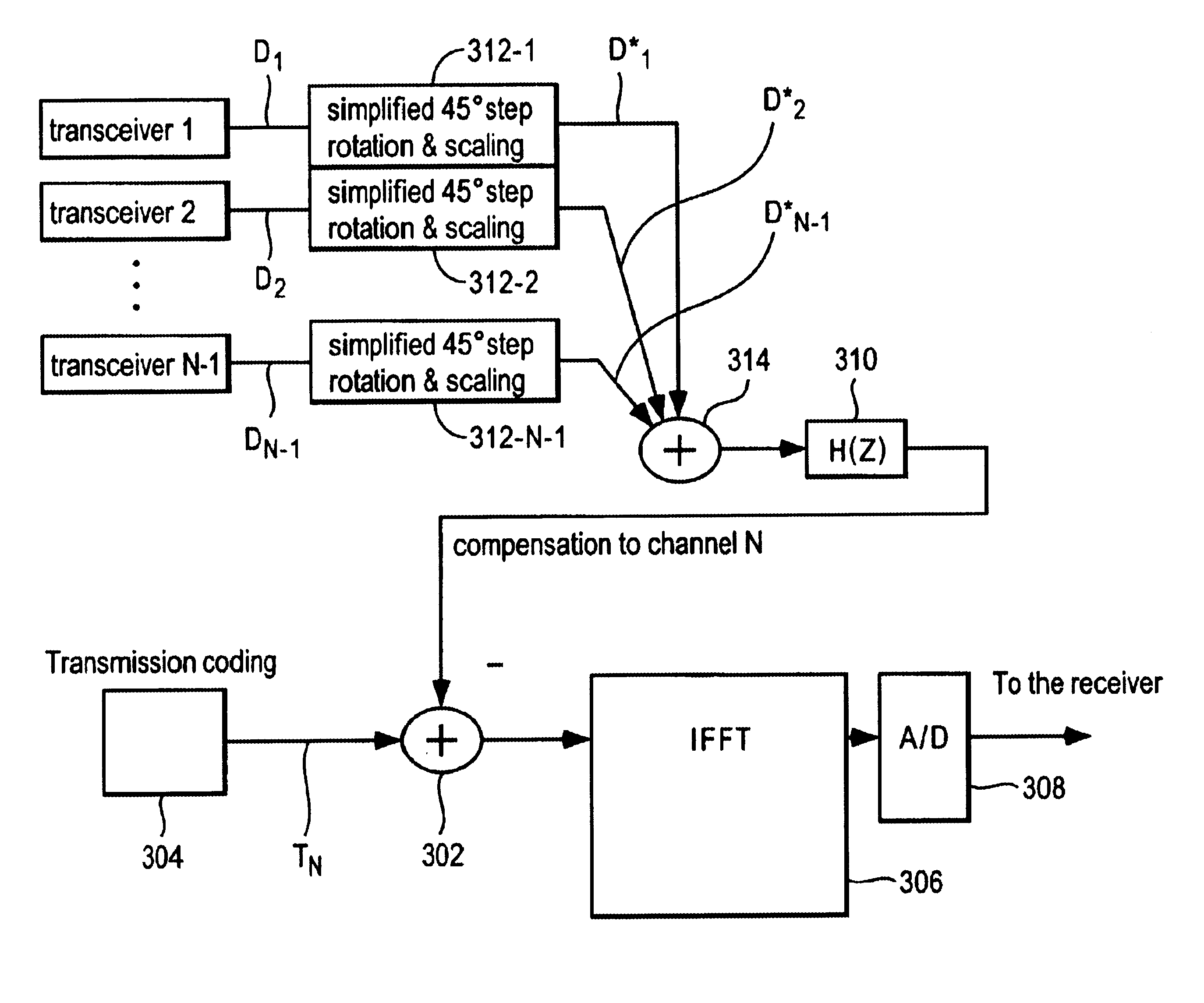Method and device for reducing crosstalk interference
a crosstalk interference and transmission system technology, applied in the field of digital data duplex transmission systems, can solve the problems of difficult to avoid twisted-pair wiring from all parts of the interconnecting transmission medium, inducing electromagnetic interference on each other, and data signals being transmitted over twisted-pair phone lines at high speeds can be significantly degraded, so as to reduce crosstalk interference and reduce the effect of crosstalk interference adaptively and improve speed
- Summary
- Abstract
- Description
- Claims
- Application Information
AI Technical Summary
Benefits of technology
Problems solved by technology
Method used
Image
Examples
first embodiment
Sharing of Main Rotations among Coupling Factors Associated with a Single Disturbed Line
FIG. 3 shows, accordingly, a conceptual diagram of crosstalk reduction on a line according to a first embodiment of the present invention.
Compensation, i.e. crosstalk reduction, of a signal on a line or channel N is preferably introduced at 302, i.e. in the transmitter N after transmission coding 304, but before modulation by the fast inverse Fourier transform (IFFT) 306 and analog-to-digital conversion 308, where the signal still is in the frequency plane. Detailed descriptions of the principle of multitone modulation as such may be found in J. A. C. Bingham, Multicarrier modulation for data transmission: an idea whose time has come, IEEE Communications Magazine, May 1990, pp. 5-14, and in references therein.
The inventive concept is to reduce the number of complex multiplications by using a finite number of filters, i.e. predetermined fixed or adaptive filters. In FIG. 3 only one complex multipl...
second embodiment
Sharing of Main Rotations among Coupling Factors Associated with a Single Crosstalk Inducing Line
As described above a complex multiplication can be performed by a pre-rotation followed by a main rotation and a scaling. But, this is equivalent to perform the main rotation before the pre-rotation. Consequently, instead of sharing main vectors for a single disturbed line, sharing may be performed, according to a second embodiment of the present invention, by considering a single disturbing signal D.sub.j on a line j. This signal D.sub.j on line j has N-1 different associated coupling factors .alpha.'.sub.j.sub..sub.-- .sub.1, .alpha.'.sub.j.sub..sub.--.sub.2, . . . , .alpha.'.sub.j.sub..sub.-- .sub.j-1 .alpha.'.sub.j.sub..sub.-- .sub.j+1, . . . , .alpha.'.sub.j.sub..sub.--.sub.N for crosstalk interferences induced on lines 1, 2, . . . , j+1, . . . , N.
By grouping said coupling factors (according to their phases) into different sets, each set being. associated with a single specific mai...
third embodiment
CORDIC Rotation
According to a third embodiment (not shown in the Figures) of the present invention any of the two previously described embodiment may be combined with the use of a vector rotation method called CORDIC (COordinate Rotation DIgital Computer) for the main rotations.
CORDIC is an iterative method for performing vector rotation, see e.g. J. E. Volder, "The CORDIC trigonometric computing technique", IRE Trans. on Electron. Computers EC-8, pp. 330-334, September, 1959. In this method a number of simple rotations that may be performed by two additions / subtractions are used. The CORDIC rotations angles are + / -arctan(2.sup.-i), where i is a positive integer. A rotation may be written
RE.sub.n+1 =RE.sub.n -s.sub.i 2.sup.-i IM.sub.n
IM.sub.n+1 =IM.sub.n +s.sub.i 2.sup.-i RE.sub.n
Where RE is the real part and IM is the imaginary part of the vector to rotate and s.sub.i has the value +1 or -1 depending on the direction the rotation is made.
In hardware a CORDIC rotation is easy to acc...
PUM
 Login to View More
Login to View More Abstract
Description
Claims
Application Information
 Login to View More
Login to View More - R&D
- Intellectual Property
- Life Sciences
- Materials
- Tech Scout
- Unparalleled Data Quality
- Higher Quality Content
- 60% Fewer Hallucinations
Browse by: Latest US Patents, China's latest patents, Technical Efficacy Thesaurus, Application Domain, Technology Topic, Popular Technical Reports.
© 2025 PatSnap. All rights reserved.Legal|Privacy policy|Modern Slavery Act Transparency Statement|Sitemap|About US| Contact US: help@patsnap.com



